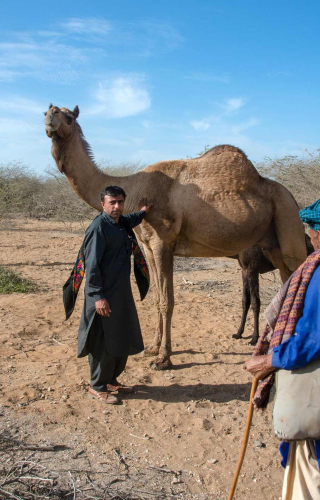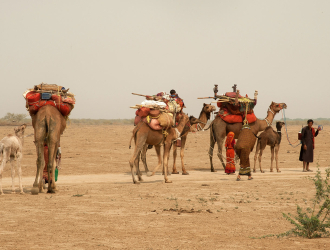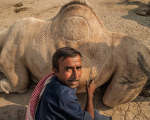The Great Rann of Kutch (also Kachchh) is home to itinerant pastoral communities, who though diverse in their religious beliefs, communities and castes, are collectively called ‘maldhari’ in Gujarati/Kutchi language, derived from ‘mal’, which refers to the value of their livestock, and ‘dhari’ meaning owner of the herds.
For centuries, maldharis traversed migration routes across the Rann of Kutch. The Banni grassland ecosystem—on the southern edge of the Great Rann—is a major grazing land for maldharis. Within society, the maldharis are traditional dairymen, supplying essential commodities like butter, ghee, milk, wool and manure to urban towns and villages. Because they live in a desert environment and constantly move around, the maldharis are reliant on camels for transport, but their pastoral animals include sheep, goats, buffaloes and cows, many of which are indigenous breeds of the region.
In Kutch district, there are two camel-breeding maldhari communities: the Rabaris and the Jats. The long-standing relationship between the Rabaris and the Jats are narrated in an old story of two Rabari brothers who had a disagreement over owning a camel. To resolve their dispute, they went to meet Savla Pir, a revered Muslim saint. Savla Pir created a camel out of beeswax and asked the brothers to choose between the two camels. The elder brother immediately picked the living camel and left. The younger one, Devidas Rebari, was given the wax camel, and the saint blessed Devidas, saying a camel herd will follow Devidas on his return journey, but he must not look back till he reached home. Devidas could not hold his curiosity and just before arriving home, he looked back. He saw a sizeable number of camels following him, but their numbers stopped increasing because he had looked back. Savla Pir had also told Devidas, should he find himself with too many camels, he may entrust them to the care of the Jats. Even today, Jat communities take care of camels assigned to them by the Rabaris.
The Jats of Kutch are distinct from the Jats of Northern India and the Jats of Sindh, in Pakistan. The Jats of Kutch are made up of four communities: the Fakirani Jats, the Hajiyani Jats, the Daneta Jats and the Garasiya Jats. The four communities are further divided into many clans and sub-clans. Of these, only the Fakirani and Hajiyani Jats are camel breeders. These camels are an eco-tonal breed that can survive on dryland ecosystem, as well as the coastal ecosystem. Known as ‘Kharai’, the camels can swim to reach mangroves growing in saltwater. These mangroves have high salinity, and only the kharai camels have the tolerance to feed on them; this is why they are called Kharai, which means ‘salty’ in Gujarati/Kutchi language. In 2015, the Kharai was recognised as a separate breed (distinct from Kutchi camels) by the National Bureau of Animal Genetic Resources.
I first encountered Kharai camels in 2015, in a coastal village named Mohadi, in Abdasa taluka, Kutch. I saw the camels returning from a bet(island), swimming through salt marshes. During summer months, this is common grazing practice for Kharai camels. They spent 3 to 4 days feeding around isolated bets and return to the villages for a day or two for drinking water. Ismail Jat, the owner of the camels, informed me that the mangroves form an essential part of their diet. If the camels don’t feed in the mangroves for a long time, the animals fall sick and eventually die. The Kharai camel’s main food source, the mangrove forests, have been fast disappearing due to overgrazing and increasing industrialisation.
Due to its rich deposit of salt brought in with seawater, the region has been opened to salt mining industries. Beginning in January 2018, more than four square kilometres of thriving mangrove forests were destroyed because of illegal activities of the salt industry. The companies first blocked large creeks that supply tidal waters to the mangroves, in order to dry them up and kill them. Once the mangroves were dead, they used excavators to clear the land and prepare them for harvesting salt. This destruction was first noticed by Fakirani Jat camel herders, and they raised their collective voice against it. The Kutch Camel Breeders Association (Kutch Unth Ucherak Maldhari Sangathan, or KUUMS) launched protests against this unlawful act of salt manufacturing companies. This was in violation of Coastal Regulation Zone (CRZ) Act, 2011. Fortunately, with the intervention of the National Green Tribunal (NGT), a stay order was obtained in March, and, on August 1, the NGT ordered the Gujarat Pollution Control Board to reopen the tidal creeks in the area. For now, damage to both, the mangroves and the Kharai camels, has been prevented, at least temporarily.
Later I visited Lakhpat taluka, the westernmost fringe of India, which has a population of Fakirani Jats. In the past they were entirely nomadic and constantly on the move in search of new pastures, usually within their taluka. But most Fakirani Jats living in Lakhpat lead a sedentary life in their traditional pakkhas (houses assembled from reed grass, jute, wood and rope). These houses are constructed by the Fakirani Jat women, who also play an active role in camel breeding. They take care of the newborn camels, and forage for fodder for the camels. The absence of grazing grounds for their Kharai camels is a major reason why the Fakirani Jats here are increasingly shifting to a sedentary life. Moreover, severe drought in the entire region has made their pastoralist life difficult to sustain.
The Fakirani Jats also complained about an invasive plant called Gando Bawal (Prosopis juliflora). This plant is not native to the region but was introduced by the Gujarat State Forest Department to resist salinity ingress and soil erosion. In the 1980s, a ban was imposed on its cutting. Unchecked, the plant spread rapidly, destroying the grasslands. The government lifted the ban in 2004, but this soon backfired, leading to indiscriminate deforestation. The ban was again reimposed in 2008. A series of such miscalculated events have led to a decline in the wild bee population, and this has severely impacted wild bee honey collection on which the local Koli community depends. The decline in wild bees has also interrupted crop pollination and this has resulted in lower crop yields in the Kutch district.
But despite of so many problems, the Fakirani Jats are hopeful about the future. The community has benefitted by the setting up of Kutch Camel Breeders Association (Kutch Unth Ucherak Maldhari Sangathan, or KUUMS) in 2011, with 350 camel pastoralists becoming members of KUUMS. Through their lobbying, in December 2016, camel milk was recognized by FSSAI (Food Safety and Standards Authority of India) as an edible food item. A new brand of camel milk chocolate has been launched by Amul. KUUMS has collaborated with craft organizations to produce camel-hair products such as carpets, stoles and fabric. These innovations have led to increased demand for camels, and the prices of Kharai camels have gone up. It was also due to effort of KUUMS, that the Government of India declared the Kharai camels as a ‘highly threatened’ breed, and has launched a massive conservation programmme to increase Kharai numbers. However, along with the thousands of flora and fauna species that live in the mangroves, the Kharai camels too will perish without the mangroves being protected first.

















